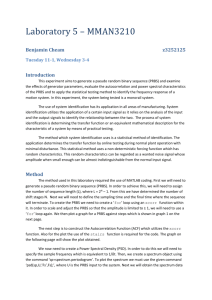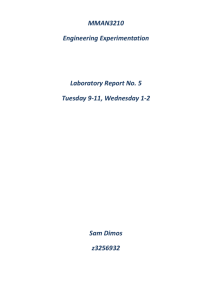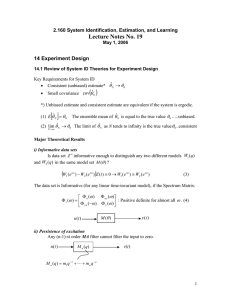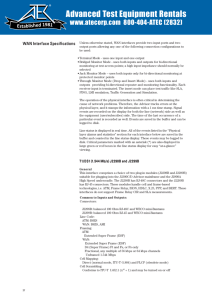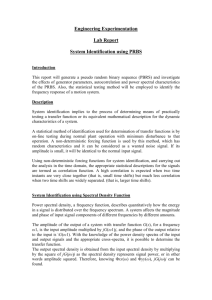System Identification of Power Converters With Digital Control
advertisement
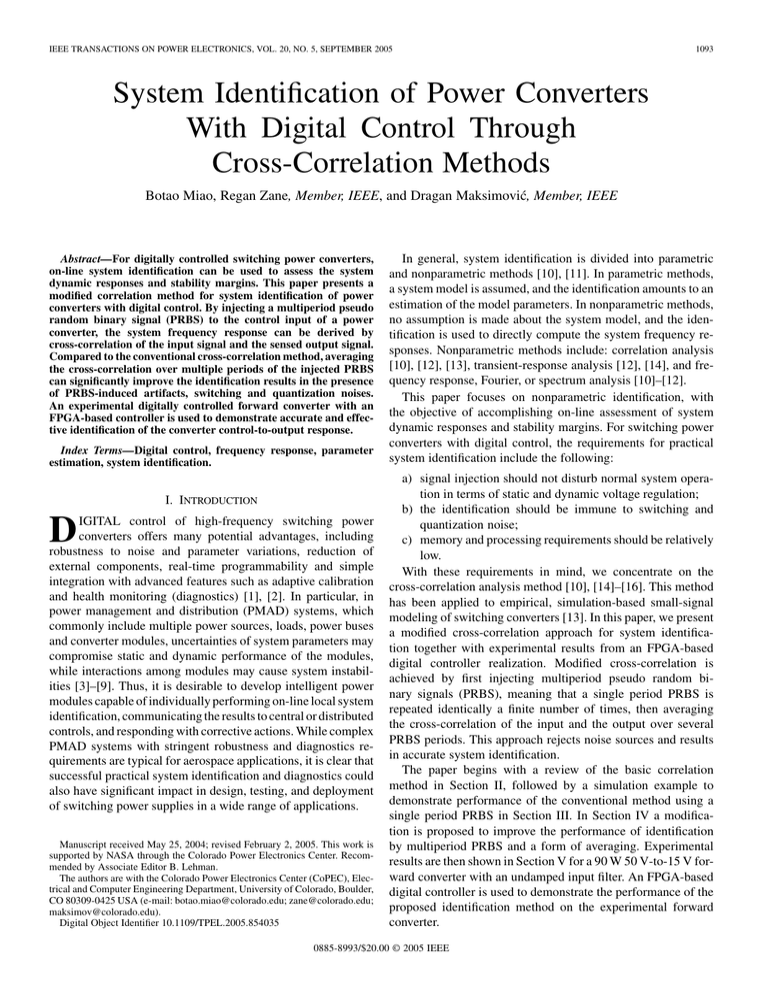
IEEE TRANSACTIONS ON POWER ELECTRONICS, VOL. 20, NO. 5, SEPTEMBER 2005 1093 System Identification of Power Converters With Digital Control Through Cross-Correlation Methods Botao Miao, Regan Zane, Member, IEEE, and Dragan Maksimović, Member, IEEE Abstract—For digitally controlled switching power converters, on-line system identification can be used to assess the system dynamic responses and stability margins. This paper presents a modified correlation method for system identification of power converters with digital control. By injecting a multiperiod pseudo random binary signal (PRBS) to the control input of a power converter, the system frequency response can be derived by cross-correlation of the input signal and the sensed output signal. Compared to the conventional cross-correlation method, averaging the cross-correlation over multiple periods of the injected PRBS can significantly improve the identification results in the presence of PRBS-induced artifacts, switching and quantization noises. An experimental digitally controlled forward converter with an FPGA-based controller is used to demonstrate accurate and effective identification of the converter control-to-output response. Index Terms—Digital control, frequency response, parameter estimation, system identification. I. INTRODUCTION D IGITAL control of high-frequency switching power converters offers many potential advantages, including robustness to noise and parameter variations, reduction of external components, real-time programmability and simple integration with advanced features such as adaptive calibration and health monitoring (diagnostics) [1], [2]. In particular, in power management and distribution (PMAD) systems, which commonly include multiple power sources, loads, power buses and converter modules, uncertainties of system parameters may compromise static and dynamic performance of the modules, while interactions among modules may cause system instabilities [3]–[9]. Thus, it is desirable to develop intelligent power modules capable of individually performing on-line local system identification, communicating the results to central or distributed controls, and responding with corrective actions. While complex PMAD systems with stringent robustness and diagnostics requirements are typical for aerospace applications, it is clear that successful practical system identification and diagnostics could also have significant impact in design, testing, and deployment of switching power supplies in a wide range of applications. Manuscript received May 25, 2004; revised February 2, 2005. This work is supported by NASA through the Colorado Power Electronics Center. Recommended by Associate Editor B. Lehman. The authors are with the Colorado Power Electronics Center (CoPEC), Electrical and Computer Engineering Department, University of Colorado, Boulder, CO 80309-0425 USA (e-mail: botao.miao@colorado.edu; zane@colorado.edu; maksimov@colorado.edu). Digital Object Identifier 10.1109/TPEL.2005.854035 In general, system identification is divided into parametric and nonparametric methods [10], [11]. In parametric methods, a system model is assumed, and the identification amounts to an estimation of the model parameters. In nonparametric methods, no assumption is made about the system model, and the identification is used to directly compute the system frequency responses. Nonparametric methods include: correlation analysis [10], [12], [13], transient-response analysis [12], [14], and frequency response, Fourier, or spectrum analysis [10]–[12]. This paper focuses on nonparametric identification, with the objective of accomplishing on-line assessment of system dynamic responses and stability margins. For switching power converters with digital control, the requirements for practical system identification include the following: a) signal injection should not disturb normal system operation in terms of static and dynamic voltage regulation; b) the identification should be immune to switching and quantization noise; c) memory and processing requirements should be relatively low. With these requirements in mind, we concentrate on the cross-correlation analysis method [10], [14]–[16]. This method has been applied to empirical, simulation-based small-signal modeling of switching converters [13]. In this paper, we present a modified cross-correlation approach for system identification together with experimental results from an FPGA-based digital controller realization. Modified cross-correlation is achieved by first injecting multiperiod pseudo random binary signals (PRBS), meaning that a single period PRBS is repeated identically a finite number of times, then averaging the cross-correlation of the input and the output over several PRBS periods. This approach rejects noise sources and results in accurate system identification. The paper begins with a review of the basic correlation method in Section II, followed by a simulation example to demonstrate performance of the conventional method using a single period PRBS in Section III. In Section IV a modification is proposed to improve the performance of identification by multiperiod PRBS and a form of averaging. Experimental results are then shown in Section V for a 90 W 50 V-to-15 V forward converter with an undamped input filter. An FPGA-based digital controller is used to demonstrate the performance of the proposed identification method on the experimental forward converter. 0885-8993/$20.00 © 2005 IEEE 1094 IEEE TRANSACTIONS ON POWER ELECTRONICS, VOL. 20, NO. 5, SEPTEMBER 2005 II. CROSS-CORRELATION METHOD Here we review and study application of the cross-correlation method to digitally sampled and controlled switching power converters. In steady state, for small-signal disturbances, a power converter can be regarded as a linear time-invariant discrete-time system, where the sampled system can be described by (1) where is the sampled output signal; is the input digis the discrete-time system impulse reital control signal; represents disturbances, including switching sponse; and noise, measurement error, quantization noise, etc. and the The cross-correlation of the input control signal is output signal (2) Fig. 1. (a) White noise and (b) its auto correlation. (c) Single period PRBS and (d) its auto correlation. Sampling frequency is 100 kHz. is the auto-correlation of the input signal. Now, where is selected to be white noise, then if the input control signal we benefit from the following characteristics: (3) In other words, the auto-correlation of the input is an ideal delta function and the cross-correlation of the white noise input is ideally zero. Under the conditions of with disturbances (3), the cross-correlation of (2) can be reduced to (4) Thus the cross-correlation of the input and output sampled signals give the discrete time system impulse response. The control-to-output transfer function of the target power converter in frequency domain can then be derived by applying the discrete Fourier transform (DFT) to (5) This theoretical result requires the ability to generate white noise as an input perturbation to the system. A simple compromise in a digitally controlled power converter is to approximate white noise through use of PRBS perturbations. The PRBS can be easily generated but is periodic and deterministic [10], [15], [16]. The data length for one period of an -bit maximum length PRBS is given by , and the signal itself has only . two possible values: Fig. 1 shows a comparison of samples of white noise (a) and a 9-b single period PRBS (c) (only part signal is shown) in a Fig. 2. 9-b PRBS generated by a 9-b shift register. digital system. Fig. 1(b) and (d) show the corresponding autocorrelation functions, respectively. We can see that the auto-correlation of a single period PRBS is very close to a delta function, but now with a nonideal component (or noise) around it. Recall from (2) that the cross-correlation between the input and output can be seen as time convolution between the autocorrelation of the input (ideally a delta function) and the system impulse response. The additional noise in the PRBS autocorrelation will create errors in our identification process. The PRBS perturbation signal can be easily generated in a digital system using a shift register with feedback [10], [13], as shown in Fig. 2 for a 9-b PRBS. An n-bit feedback shift register can generate several different sequences, among which the maximum length sequence has the best properties (optimal noiselike characteristic) for this application. The maximum length PRBS can be generated by performing an XOR operation between the i-th bit and a specific j-th bit. For a 9-b shift register, the XOR operation should be performed between the first and the fifth bits, as shown in Fig. 2. The output generated by a one-bit right shift operation produces a maximum length sequence of 511 before repetition occurs. In Section IV, the properties of the maximum length sequence PRBS is described. The following section illustrates application of the basic correlation method through a simulation example. MIAO et al.: SYSTEM IDENTIFICATION OF POWER CONVERTERS 1095 Fig. 3. Forward converter with input filter and digital controller block diagram. III. SIMULATION EXAMPLE: FORWARD CONVERTER IDENTIFICATION Fig. 3 shows a digitally controlled forward converter with an 50 V, undamped input filter. The converter parameters are: 15 V, 330 F, 100 H, and the load current is 6 A. The turns-ratio of the transformer is 1:1:1. The input filter is low-pass filter with 1.9 mH, 66 F. a simple The switching frequency, the sampling frequency and the PRBS frequency are all 100 kHz. Note that the input filter is not properly damped. Therefore, the converter control-to-output response exhibits a fourth-order response with a pair of right-half plane zeros [3]. This example is chosen to represent a situation where a fault in a power distribution system on the input side of the converter may cause system instabilities. It is also an example where both low-frequency and high-frequency dynamics of the converter are of interest, and the system identification problem is more challenging. The converter model and the identification functions are implemented in the MATLAB/Simulink environment. A single period maximum length 10-b PRBS signal (data length is 1023) is injected as a perturbation to the converter digital duty cycle command. In this paper, denotes the perturbation signal. The steady-state duty cycle is 0.3. The magnitude of the PRBS signal should be small enough in order not to disturb normal system operation. In this simulation, the PRBS magnitude is a duty cycle perturbation of 0.01. The additional output voltage ripple caused by PRBS perturbation is about 0.6 V, or about of the dc output voltage. Fig. 4 shows the simulation results: a) the cross-correlation of the input and output signals and b) the frequency responses obtained by DFT of the cross-correlation data in a). The solid curves represent the magnitude and phase responses of the control to output transfer function obtained for the converter ideal averaged model (excluding losses) [3], while the dashed curves represent the responses obtained by the basic cross-correlation method. Fig. 4. Simulation results of a forward converter with an undamped input filter when input is one period 10-b PRBS L 1; M 1023, frequency of PRBS is 100 kHz. (a) cross-correlation of the input and output and (b) frequency response from correlation method (dashed) and ideal averaged model (solid). = = It can be observed that the salient features of the converter responses are well identified by the method. However, the high frequency responses obtained by the identification method are significantly corrupted by noise. In the next section, we discuss selection of the identification parameters as well as modifications to the basic method aimed at reducing the effects of noise. IV. MODIFIED CORRELATION METHOD: MULTIPERIOD AND AVERAGING APPROACH Recall from Fig. 1(d) that the nonzero noise in the auto-correlation of a single-period PRBS was expected to result in errors in the calculated system impulse response, which can now be seen in Fig. 4. In this section, we develop options for improving the identification results through processing multiple periods of the PRBS sequence. Consider first the properties of an infinite period PRBS. A maximum length PRBS repeated times forms an -period 1096 IEEE TRANSACTIONS ON POWER ELECTRONICS, VOL. 20, NO. 5, SEPTEMBER 2005 Fig. 6. Auto correlation of (a) a single period 10-b PRBS and (b) a four-period 8-b PRBS. Fig. 5. (a) Auto correlation and (b) frequency spectrum of an infinite period PRBS. PRBS. If tends to infinity, it has the following properties and frequency spectrum [10]: (6) (7) (8) Equation (6) gives the mean value of an infinite period PRBS, which tends to zero for large . Interestingly, (7) shows a key result: for an infinite period PRBS, the autocorrelation is given by periodic delta functions with magnitude at equal to zero for all the other ’s, and multiples of , and equal to is large, , which is also shown in Fig. 5(a). When resulting in a periodic sequence of near ideal delta functions in the auto correlation. This is also seen in the frequency domain, as shown in the frequency spectrum of (8). Fig. 5(b) shows a plot of (8), where it is seen that the frequency content of an infor finitely repeating PRBS contains delta functions at , where is the frequency of the PRBS. Thus the infinitely repeating PRBS can be seen as equivalent discrete frequencies , reto injecting signals at sulting in a clear limitation to the frequency components that can be identified in the power converter. In comparison, injection of white noise results in a flat line in the frequency domain, or is equivalent to signal injection at all frequencies for ideal system identification. Thus, for large , an infinitely repeating PRBS injection would result in near ideal identification. In practice, due to limitations in memory and computation capability, only finite length data can be used. However, we still see significant improvements in performance through use of finite but multiperiod PRBS over single-period. This is partially Fig. 7. Noise variance versus data length and 12-b. N with M = 8-, 9-, 10-, 11-, explained by improvement in the autocorrelation function, as shown in Fig. 6, which compares a single period 10-b PRBS to . For a four-period 8-b PRBS. The total data length is 1023. For four-period 8-b single period 10-b PRBS, 4 255 1020. Thus while the two have PRBS, essentially the same data length, the four-period signal has a significantly lower relative noise magnitude when compared to the single period version. This characteristic is further explored in Fig. 7, which shows the relationship between noise variance and . The horizontal axis is the data length and the vertical axis is the noise variance on a log scale. When is fixed, (that is larger ) gives lower noise variance. Thus, if smaller the effective noise in the input PRBS auto-correlation were the only consideration, it would be best to use the largest possible (multiple periods) for a given allowable data length. However, there are additional constraints on the selection in the context of identification of a digitally controlled of switching power converter. The primary consideration in seis based on achieving desired frequency sampling lecting and resolution, as shown in Fig. 5(b). In (loosely defined) comparison to network or spectrum analyzer terms, the “start” and “stop” frequencies of the effective frequency sweep are and (after DFT), respectively, where given by is the PRBS frequency. In addition, the equivalent “resolution . bandwidth” or spacing between frequency samples is must be sufficiently high to capture the desired high Thus, frequency content, while must be sufficiently small to MIAO et al.: SYSTEM IDENTIFICATION OF POWER CONVERTERS 1097 Fig. 9. Cross-correlation result when input is a multiperiod PRBS signal. Note reduced amplitude side-bands due to finite periods in the input PRBS. Fig. 8. Simulation results of a 100 kHz forward converter with an undamped input filter when the input is two period 9-b PRBS L 2; M =511, frequency of PRBS is 50 kHz. Frequency response from correlation method (dashed) and ideal averaged model (solid). Compare to Fig. 4 for single-period (L = 1). = capture low frequency content and achieve the desired frequency resolution. Another way to visualize the low frequency requirement is that the sampling window of a single PRBS ) must be sufficiently period in the time domain (given by longer than the system settling time. Based on the above constraints, suitable and minimum can be selected based on desired frequency sampling, followed by maximum based on allowed total data length. Also, note that must be an integer value to maintain the desired for auto-correlation characteristics. The concept of trading is demonstrated in Fig. 8, where simulation results for a twoperiod, nine-b sequence at 50 kHz PRBS can be compared with the single period, 10-b, 100 kHz PRBS of Fig. 4. The forward converter switching frequency is 100 kHz for both cases. An improved system identification is achieved in Fig. 8 (two-period), while Fig. 4 (one-period) has a higher maximum frequency (2x). Both approaches have essentially the same total data length. Up to this point, our discussion has focused on the quality of the PRBS input signal. With the emphasis now on injecting multiple PRBS periods, an additional consideration is how to handle the multiperiod data sampled at the switching converter output. As suggested in [1], one possibility is to average the sampled output voltages and work only with one period of input and output data in the cross-correlation for reduced computational reduction of external complexity. This approach achieves a , from averaging but no additional reduction noise sources, from the nonideal behavior of the input PRBS auto-correlation. Alternatively, we propose to perform the cross-correlation operation on the entire set of multiperiod input and output data, followed by an effective averaging of the result to estimate the system impulse response. To estimate the effect on external noise sources, consider again (1)–(4), where for white noise input the cross-correlation operation eliminates uncorrelated noise. Based on the above selection criteria, we achieve a close approximation to white noise and expect a significant improvement in noise reduction through cross-correlation as compared to straight output data averaging. Additionally, depending on how we deal with the output of the cross-correlation data, it is possible to achieve further cancellation of nonideal components in the PRBS auto-correlation as described below. From (2), we know the cross-correlation is equal to the convolution of input sequence auto-correlation and system impulse response. When the input signal is multiperiod, the cross-correlation result is a multiperiod impulse response, as shown in Fig. 9. The reduced amplitude side-bands are due to the finite periods in the input sequence. There are two options to deal with the multiperiod correlation result. One is to truncate impulse the sidebands and take only the center of the responses as our result based on the observation that its signal to noise ratio is the best among the impulse responses. The other is to average all of the resulting impulse responses over periods. Intuitively, it appears that the would reduce signal integrity due to the reduced sideband amplitudes. However, we have observed improvement in the identification result using the averaging approach over use of the center impulse only, and we use the averaging approach in our experimental results presented in Section V. The improvement through averaging can be understood qualitatively by recognizing a key property of the PRBS, where the same position points in each segment of the auto-correlation have following relation [1]: (9) where is a constant and the right hand term in (9) is very small when compared to the noise levels seen in Fig. 6 for use of finite PRBS periods. Now recall that the cross-correlation between the input and output is equivalent to convolution of the auto-correlation and the system impulse response. If the system had an ideal delta function as its impulse response, the output of the cross-correlation would be the auto-correlation of the PRBS. In this case, averaging of the output responses would result in a cancellation of the noise created by the PRBS according to (9) and we would have near perfect identification similar to use of ideal white noise. With a real system impulse response, the convolution operation adds in additional noise points that are not cancelled according to (9) when averaging the output responses. However, by design, the system impulse response has a settling time significantly less than the sample time of the PRBS, and a portion of the PRBS noise is cancelled according to (9). The extent of noise cancellation is dependant on the system response, PRBS, and sampling time. Based on the above discussions, our proposed procedure for system identification is summarized in the signal flow graph 1098 IEEE TRANSACTIONS ON POWER ELECTRONICS, VOL. 20, NO. 5, SEPTEMBER 2005 Fig. 10. Signal flow graph of the proposed system identification approach in digitally controlled switching power converters. of Fig. 10. First, identification should be performed when the system is operating in steady state. To start, an -period n-bit PRBS is generated and injected to the control input. At the same time, the output of the system is sampled and stored. After the injection and output data collection are finished, the crosscorrelation is computed over the entire data sequence. The impulse responses output from the cross-correlation operation are summed, and then divided by . Finally, the DFT is applied to the averaged cross-correlation result to visualize the system frequency response. V. EXPERIMENTAL VERIFICATION The digitally controlled forward converter of Fig. 3 was constructed and used to experimentally verify the proposed system identification method. The converter parameters are the same as in the simulation example of Section III: the input voltage 50 V and the output voltage is 15 V. The output is 100 H, and the output filter capacitor is filter inductor is 330 F. The converter operates at the nominal load of 6 A. 100 kHz. The turns-ratio of The switching frequency is the transformer is 1:1:1. The input filter parameters are 1.9 mH and 66 F. The digital controller was implemented using a Xilinx Virtex-II FPGA. The FPGA-based controller includes a 10-b digital pulse-width modular, a PRBS generator and a data collection unit. The converter output voltage, scaled by a 10:1 resistive voltage divider, is sampled by an A/D converter (TI-THS1230). The sampling rate equals the switching frequency. Although the FPGA also includes a discrete-time compensator to implement closed-loop output voltage regulation, in the experiments reported in this section the converter is operated open loop. The PRBS and A/D data collected by the FPGA is transmitted to a PC for off-line processing in the MATLAB/Simulink environment. The modified cross-correlation method described in Section IV is used to identify the control to output transfer function of the experimental forward converter. A three-period 12-b PRBS was generated by the FPGA and injected to the digital duty cycle command. The total data length is Fig. 11. Experimental frequency response of 100 kHz, 90 W forward converter based on the proposed system identification method. Dashed result is based on measured data from the digital identification system with a three-period, 12-b 12 285, and a PRBS frequency of 100 kHz. The solid PRBS, data length line is measured by a network analyzer. N= . The PRBS frequency equals the switching frequency , which means that the process of collecting the data takes 123 ms. A single PRBS sequence lasts 41 ms, which is sufficiently long to capture the complete impulse response of the converter. The corresponding frequency resolution is 24 Hz, which can be compared to the resolution bandwidth setting in a standard analog measurement of converter transfer functions using a network analyzer. Fig. 11 compares the magnitude and phase responses obtained by the modified correlation method (dotted line) and by the network analyzer measurement (solid line) under the same operating conditions. It can be observed that the matching between the responses is quite good in a wide range of frequencies. The results obtained by the identification method show a relatively low level of noise even at high frequencies. VI. CONCLUSION A modified cross-correlation method for experimental system identification is presented for switching power converters with digital control. Multiple periods of a pseudo random binary signal (PRBS) are injected to a control input (such as the duty cycle) of a power converter, and the output is sampled over multiple PRBS periods. The computed cross-correlation is averaged over multiple periods to get the system impulse response, which is then used to compute the system frequency response. Simulations and experimental results show that the proposed method can give reliable identification results in the presence of PRBS artifacts, switching and quantization noise (in digital systems). The method is well suited for implementation in digitally controlled switching power converters. As an example of such an application, a digitally controlled 50-to-15 V forward converter operating at 100 kHz is constructed and the identification method is demonstrated using an FPGA-based digital controller. The experimental results show successful control-to-output response identification. MIAO et al.: SYSTEM IDENTIFICATION OF POWER CONVERTERS The proposed identification approach can be used for off-line system analysis, digital controller design, and even design validation in the presence of nonidealities such as losses, delays and switching and quantization noise. In addition, the concepts can be extended for use in on-line applications, such as PMAD systems where static and dynamic performance of individual power modules and interactions between modules can be monitored and actively compensated locally to achieve global system stability. 1099 Botao Miao received the B.S., M.S., and Ph.D. degrees in electrical engineering from Tsinghua University, Beijing, China, in 1998, 2001, 2003, respectively. He is now doing his Post-doctoral work at the Colorado Power Electronics Center (CoPEC), University of Colorado at Boulder. His current research work is the digital control of power converters. REFERENCES [1] D. Maksimovic, R. Zane, and R. Erickson, “Impact of digital control in power electronics,” in Proc. IEEE Int. Symp. Power Semiconductor Devices ICs, Kitakyushu, Japan, May 2004. [2] IEEE Trans. Power Electron., vol. 18, no. 1, pp. 293–504, Jan. 2003. [3] R. D. Middlebrook, “Input filter considerations in design and application of switching regulators,” in Proc. IEEE Industry Applications Soc. Annu. Meeting, 1976, pp. 366–382. [4] R. W. Erickson and D. Maksimovic, Fundamentals of Power Electronics, 2nd ed. Boston, MA: Kluwer, 2001. [5] J. Jang and R. Erickson, “Physical origins of input filter oscillations in current programmed converters,” IEEE Trans. Power Electron., vol. 7, no. 4, pp. 725–733, Oct. 1992. [6] F. Xiaogang, Y. Zhihong, X. Kun, F. C. Lee, and D. Borojevic, “Impedance specification and impedance improvement for dc distributed power system,” in Proc. IEEE PESC’99, 1999, pp. 889–894. [7] S. D. Sudhoff and S. F. Glover, “Three-dimensional stability analysis of dc power electronics based systems,” in Proc. IEEE PESC’00, 2000, pp. 101–106. [8] A. Emadi, J. P. Johnson, and M. Ehsani, “Stability analysis of large dc solid-state power systems for space,” IEEE Aerosp. Electron. Syst. Mag., vol. 15, no. 2, pp. 24–30, Feb. 2000. [9] D. L. Logue and P. T. Krein, “Preventing instability in dc distribution systems by using power buffering,” in Proc. IEEE PESC’01, 2001, pp. 33–37. [10] L. Ljung, System Identification: Theory for the User, 2nd ed. Englewood Cliffs, NJ: Prentice-Hall, 1999. [11] G. F. Franklin, J. D. Powell, and M. Workman, Digital Control of Dynamic Systems, 3rd ed. New York: Addison-Wesley, 1997. [12] B. Johansson and M. Lenells, “Possibilities of obtaining small-signal models of DC-to-DC power converters by means of system identification,” in Proc. Telecommunications Energy Conf., 2000, pp. 65–75. [13] P. Huynh and B. H. Cho, “Empirical small-signal modeling of switching converters using PSpice,” in Proc. IEEE PESC’95, 1995, pp. 801–808. [14] D. Maksimovic, “Computer-aided small-signal analysis based on impulse response of DC/DC switching power converters,” IEEE Trans. Power Electron., vol. 15, no. 6, pp. 1183–1191, Nov. 2000. [15] K. R. Godfrey, “Introduction to binary signals used in system identification,” in Proc. Int. Conf. Control, vol. 1, 1991, pp. 161–166. [16] K. Godfrey, “Design and application of multifrequency signals,” Comp. Contr. Eng. J., vol. 2, no. 4, pp. 187–195, Jul. 1991. Regan Zane (M’99) received the B.S., M.S., and Ph.D. degrees in electrical engineering from the University of Colorado at Boulder in 1996, 1998, and 1999, respectively. From 1999 to 2001, he was a Research Engineer with General Electric’s Global Research Center, Niskayuna, NY, where he developed mixed-signal IC controllers for electronic ballasts. Since 2001, he has been with the Department of Electrical and Computer Engineering, University of Colorado, where he is currently an Assistant Professor and faculty member of the Colorado Power Electronics Center (CoPEC). His research interests include mixed-signal IC design, modeling, analysis and control of switching power converters, and power generation and management in low-power wireless systems. Dr. Zane received the 2004 National Science Foundation (NSF) CAREER Award. Dragan Maksimović (M’89) received the B.S. and M.S. degrees in electrical engineering from the University of Belgrade, Belgrade, Yugoslavia, in 1984 and 1986, respectively, and the Ph.D. degree from the California Institute of Technology, Pasadena, in 1989. From 1989 to 1992, he was with the University of Belgrade. Since 1992 he has been with the Department of Electrical and Computer Engineering, University of Colorado at Boulder, where he is currently an Associate Professor and Co-Director of the Colorado Power Electronics Center (CoPEC). His current research interests include power electronics for low-power portable systems, digital control techniques, and mixed-signal IC design for power-management applications. Dr. Maksimović received the 1997 National Science Foundation (NSF) CAREER Award, and a Power Electronics Society Transactions Prize Paper Award.
